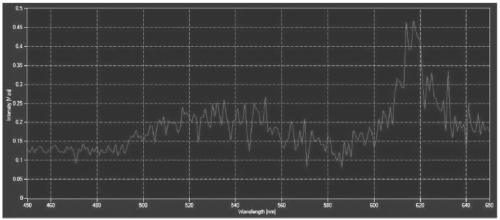Organic room-temperature phosphorescent and white-light luminescent material and preparation method thereof
A luminescent material, room temperature phosphorescence technology, applied in luminescent materials, chemical instruments and methods, organic chemistry, etc., can solve the problems of color aging, manufacturing complexity, phase separation, etc., to achieve broad application prospects, excellent warm white light emission effect
- Summary
- Abstract
- Description
- Claims
- Application Information
AI Technical Summary
Problems solved by technology
Method used
Image
Examples
Embodiment 1
[0020] Dissolve 226.23 mg (1 mmol) of 4-benzoylbenzoic acid (compound of formula I-1) in 1 mL of dichloromethane (DCM), then add 735 mg (3.5 mmol) of trifluoroacetic anhydride (TFAA), then add 167.2 mg (1mmol) carbazole, 4.9mg (0.1mmol) phosphoric acid, stirred at room temperature for 2h, column chromatography (petroleum ether / ethyl acetate=200:1, V / V), to obtain the luminescent material shown in formula II-1, its product The rate is 16%, and the reaction equation is as follows:
[0021]
[0022] The structural characterization data of the obtained luminescent material is: 1 H NMR (400MHz, DMSO) δ8.27-8.20 (m, 2H), 8.12 (d, J = 8.0Hz, 1H), 7.92 (q, J = 8.4Hz, 3H), 7.84 (d, J = 7.5Hz ,2H),7.74(dd,J=15.2,7.5Hz,2H),7.61(dd,J=13.7,6.3Hz,2H),7.50-7.37(m,5H).
Embodiment 2
[0024] In this example, the 4-benzoylbenzoic acid in Example 1 is replaced with an equimolar amount of o-benzoylbenzoic acid, and the other steps are the same as in Example 1 to obtain the luminescent material shown in formula II-2, which The yield was 43%.
[0025]
[0026] The structural characterization data of the obtained luminescent material is: 1 H NMR (300MHz, CDCl 3 )δ8.18(s,1H),7.97(dd,J=8.3,5.1Hz,3H),7.65(ddd,J=26.5,15.1,7.4Hz,3H),7.51-7.29(m,9H),7.21 (ddd,J=8.0,5.5,2.7Hz,1H).
Embodiment 3
[0028] In this example, the 4-benzoylbenzoic acid in Example 1 was replaced with 3-benzoylbenzoic acid in an equimolar amount, and the other steps were the same as in Example 1 to obtain the luminescent material shown in formula II-3, Its yield is 15%.
[0029]
[0030] The structural characterization data of the obtained luminescent material is: 1 H NMR (300MHz, CDCl 3 )δ8.15(d,J=7.8Hz,1H),8.07-7.94(m,4H),7.73(dt,J=15.2,7.5Hz,3H),7.54(dd,J=5.8,1.9Hz,3H ),7.45-7.31(m,6H).
[0031] The performance test of the luminescent material prepared by the inventor above is carried out, and the specific test is as follows:
[0032] The luminescent material is dissolved in a mixed solvent of dichloromethane and n-hexane with a volume ratio of 1:2, and then the solvent is volatilized to obtain crystals. The white light and room temperature phosphorescence properties of the obtained crystals were tested by a Hitachi F-7000 fluorescence spectrophotometer. figure 1 It is the steady-sta...
PUM
 Login to View More
Login to View More Abstract
Description
Claims
Application Information
 Login to View More
Login to View More - R&D
- Intellectual Property
- Life Sciences
- Materials
- Tech Scout
- Unparalleled Data Quality
- Higher Quality Content
- 60% Fewer Hallucinations
Browse by: Latest US Patents, China's latest patents, Technical Efficacy Thesaurus, Application Domain, Technology Topic, Popular Technical Reports.
© 2025 PatSnap. All rights reserved.Legal|Privacy policy|Modern Slavery Act Transparency Statement|Sitemap|About US| Contact US: help@patsnap.com



